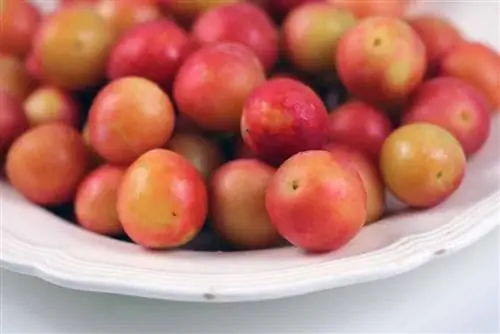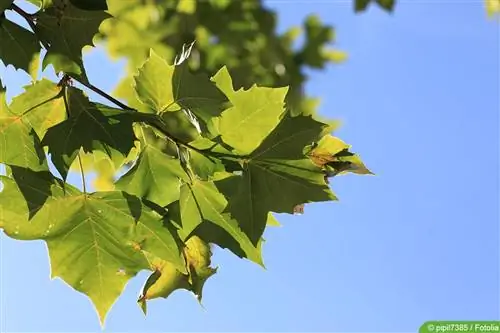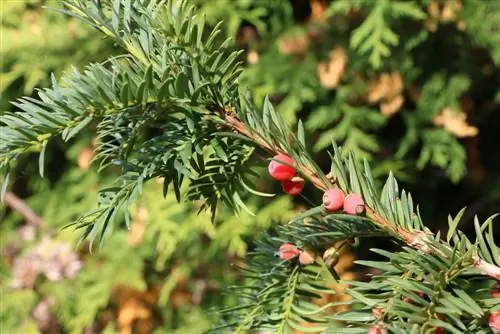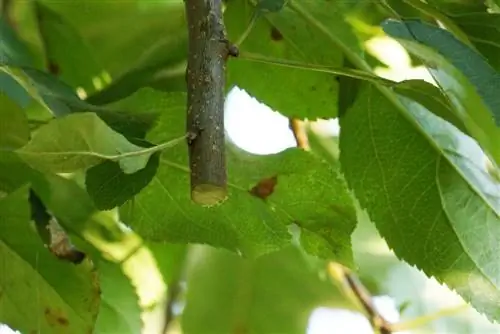- Author admin [email protected].
- Public 2023-12-17 03:39.
- Last modified 2025-01-24 12:45.
Mirabelle plums are a subspecies of the plum and grow less like a large tree than like a bush and sprawling. The small yellow fruits, up to 3 cm in size, can be harvested between July/August and September, depending on the variety. Anyone who expects long-term large yields should give this tree a certain amount of care. Correct pruning has a special status, because without regular pruning measures, flowering and the associated fruit formation quickly decline and growth also suffers.
Need for cutting measures
A mirabelle plum tree that is not cut forms many long and strong branches that bear fruit early but eventually tip under the load and after about 4-5 years they age. This is exactly what should be prevented with regular cutting measures. This is intended to ensure a regular and consistently high fruit yield over many years, prevent the trees from aging and promote he althy growth. The crown must be able to bear a variety of fruits at all times and withstand adverse weather conditions such as heavy rain and storms.
The tree should be stimulated to form new fruit wood.
In addition, pruning measures serve to protect plants, because wood and leaf diseases as well as pest infestation can quickly occur in crowns that are too dense. If you prune your mirabelle tree regularly, you can reduce the amount of pruning to what is absolutely necessary. You should always be guided by the natural growth and needs of the plant to be pruned.
Right time
The correct time to cut stone fruit, which also includes the mirabelle plum tree, is important because it determines the density of the branching but also the intensity of the shoots.
- If possible, avoid cutting the mirabelle plum tree during dormancy in winter
- Cuts would heal poorly and very slowly at this time
- This increases the risk of bark diseases and the penetration of wood parasites
- In addition, severe frost could severely damage the tissue below the incision sites
- Early spring, i.e. March/April, is ideal for heavier pruning
- Make formation cuts in summer if possible, from the end of June to the beginning of July
- During this time, shoot growth is largely complete
Cutting types
When pruning fruit trees such as the mirabelle plum, there are different types of pruning. It starts with topiary and plant pruning. This is followed by the training cut, with the aim of building a stable basic structure consisting of the main trunk, scaffolding and fruit branches. The aim of the thinning cut is to counteract aging, prevent compaction of the crown, and thus ensure better exposure.
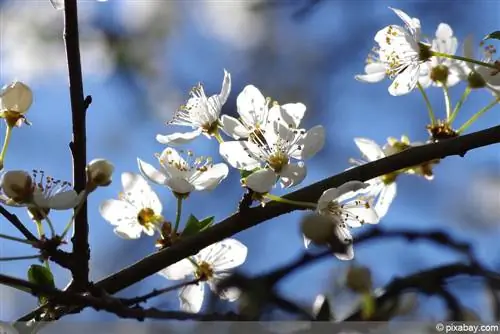
In addition, the crown volume should be maintained, the fruit wood should be thinned out and harvest fluctuations should thereby be mitigated. For older trees that have been left to their own devices for a long time, rejuvenation pruning may occasionally be necessary in order to rebuild a proper basic structure or a well-lit and ventilated crown. What is now missing is the fruit woodcut, which serves to strengthen the growth of young shoots and flower buds.
Shape and plant pruning
The topiary is already done in the tree nursery or is determined here. It is used to achieve the basic shape of the tree, for example as a low, half or standard trunk or shrub. When pruning bare-root plants, a balance must first be achieved between root and crown by removing damaged roots, shortening the remaining ones slightly and also cutting back the crown by about a third.
In addition, the initial formation of the crown takes place by determining the final number and position of the leading branches in relation to the main trunk. These three to four horizontal guide branches should be arranged evenly around the central shoot.
Educational Cut
The training pruning of the mirabelle plum tree follows the planting pruning, in which the main trunk and leading branches have usually already been established and the latter have been shortened.
- In the first five years after planting, regularly shorten the leading branches by a third
- The last eye should always face outwards
- Remove all shoots that are not needed to build a powerful crown
- This includes vertical competitive shoots as well as water shoots that grow steeply upwards
- This also applies to all shoots growing below the main branches
- The main shoot (trunk extension) should remain untouched
Conservation cut
From the sixth year onwards, maintenance pruning should be carried out regularly, directly after flowering. It is intended to keep the tree he althy and form new fruit wood to ensure consistently high yields. First, all dead, inwardly growing, crossing or cross-growing shoots are cut out. Fruit shoots that could possibly develop into competing shoots can be cut back to short cones or diverted to at least two-year-old side shoots with flower buds.
Newly formed water shoots must always be cut off directly at the point of attachment. Wild shoots that sprout from the roots or on the trunk are cut away completely.
Rejuvenation cut
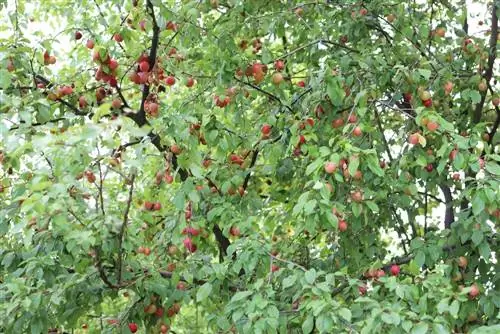
The rejuvenation cut in early spring is usually used on older or long-neglected trees where the formation of young shoots has almost come to a standstill, and is usually stronger. First you should look at the tree and check which branch combinations come closest to the ideal image of an open and airy crown.
- Then remove all branches that disturb this picture
- If necessary, cut back and thin out the old wood or medium-thick branches
- Also cut out dead branches and those that are growing into the crown
- This also applies to the water shoots, which usually grow steeply upwards on the old wood
- Water shoots are thin, weak shoots that cost the plant unnecessary energy
- Always saw off normal shoots on Astring and repeat the process over several years
Tip:
Basically, when making a rejuvenation cut, you shouldn't go at it randomly, but rather use the scissors less than once too much.
Fruit woodcut
The classic fruit pruning is necessary to limit growth and promote bud formation. Strong trees are pruned moderately and weaker trees more heavily. While wood shoots only form leaf buds, fruit wood forms flowers and consequently fruits.
The so-called fruit wood sinks downwards over the years due to the fruit covering. These hanging branches are no longer optimally supplied with water and nutrients; they produce many but small fruits. New shoots that develop at the apex of the fruit branch then take over the function of the fruit branch, so that the actual fruit branch can be cut back to this shoot.
Tip:
The further up the leading branches the fruit branches are, the shorter they should be.
Notes worth noting when editing
Regular pruning is essential for fruit trees such as the mirabelle plum tree. Missing cuts can be just as damaging to the tree as incorrect pruning.
During dormancy, any pruning measures should be avoided as the cuts would have difficulty healing, which in turn would encourage the penetration of fungi and other pests.
The stronger the pruning, the stronger the sprouting from the few remaining buds. If there is hardly any cutting, more buds remain, from which many weak new shoots develop. If the crown is cut unevenly, the higher buds will always sprout more strongly and the crown will develop irregularly. That's why it's even more important to always treat the entire crown evenly in terms of cutting intensity.
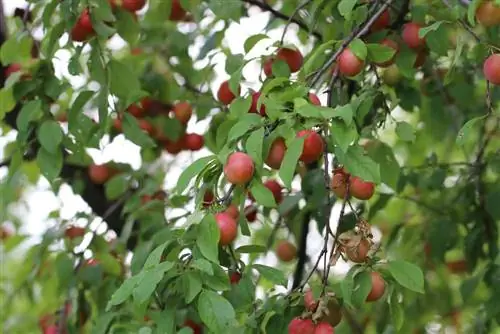
Incorrect cutting or sawing can also cause damage to the tree. For example, cutting on a branch means that you do not cut flat on the trunk, but above the small ridge that surrounds the branch at the transition to the trunk. However, the branches should not be cut off completely straight away, but rather leave around 20 cm standing initially. Then about a third of the branch is cut from below and then sawn off from above so that the load is taken off the branch and it does not tear away. Only now is the remaining piece cut off on Astring.
You should also make sure to always cut above an outer leaf bud and not too close to a bud. Otherwise, this bud could dry out and the one underneath could sprout in the wrong direction and at an unfavorable angle.
You should also avoid so-called slit branches, which can form in the first few years. These are strongly upright side shoots that are only partially or insufficiently attached to the trunk and could break off if subjected to later stress. You can find out whether a side shoot is such a slit branch or not by gently pulling on it. A split branch then usually breaks off.
Conclusion
Regular cutting measures are essential for a long-term, productive harvest. The right time and, above all, the execution of the cut play a crucial role. Trees that have not been cut for a long time tend to age prematurely, they produce fewer shoots and flower and fruit production also decreases significantly. However, if you prune too much or incorrectly, it can take a very long time for the tree to recover and develop fruit. It's best to take a close look at the mirabelle plum tree before cutting to make sure whether it needs a cut and whether it should be light or heavier.

